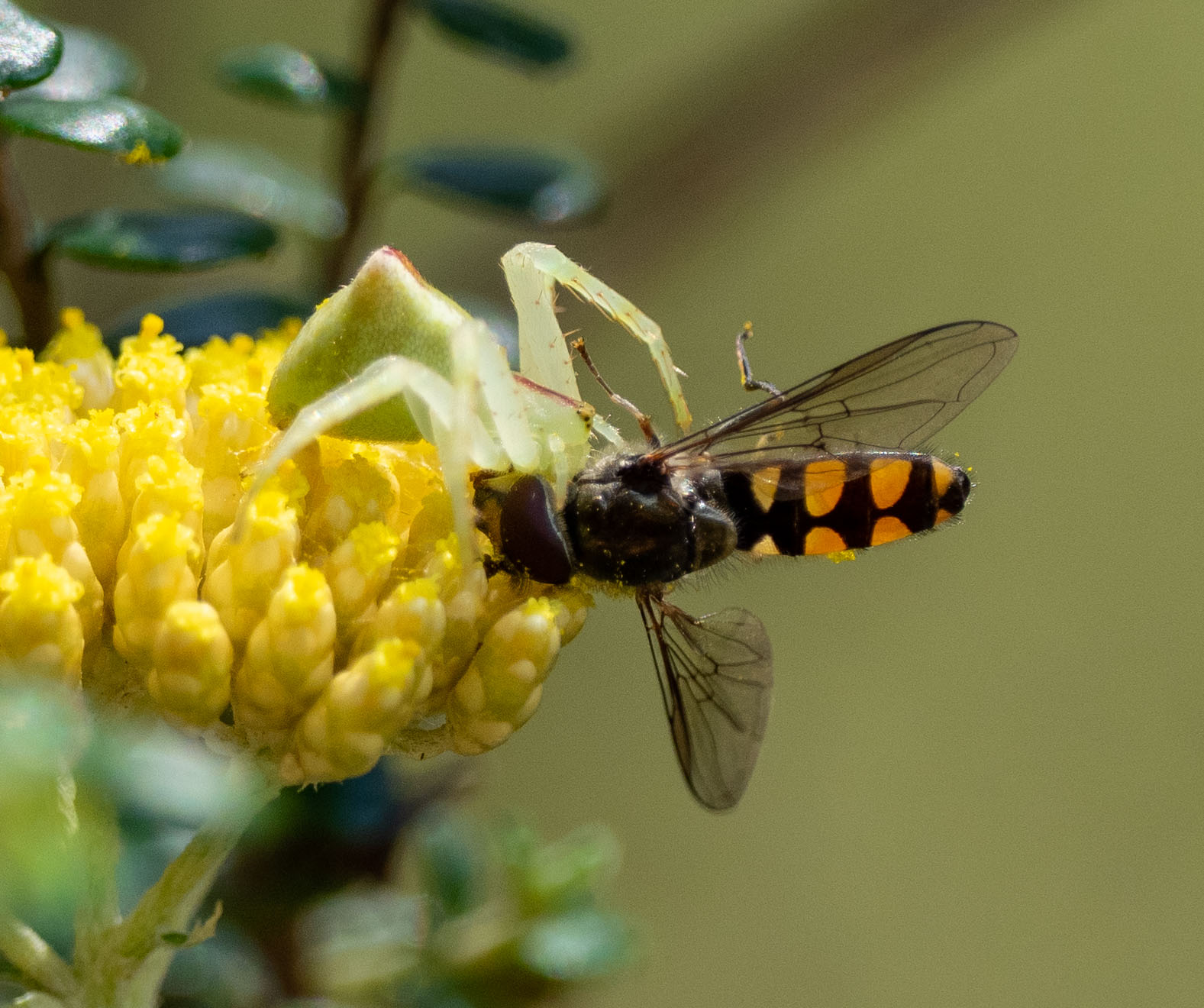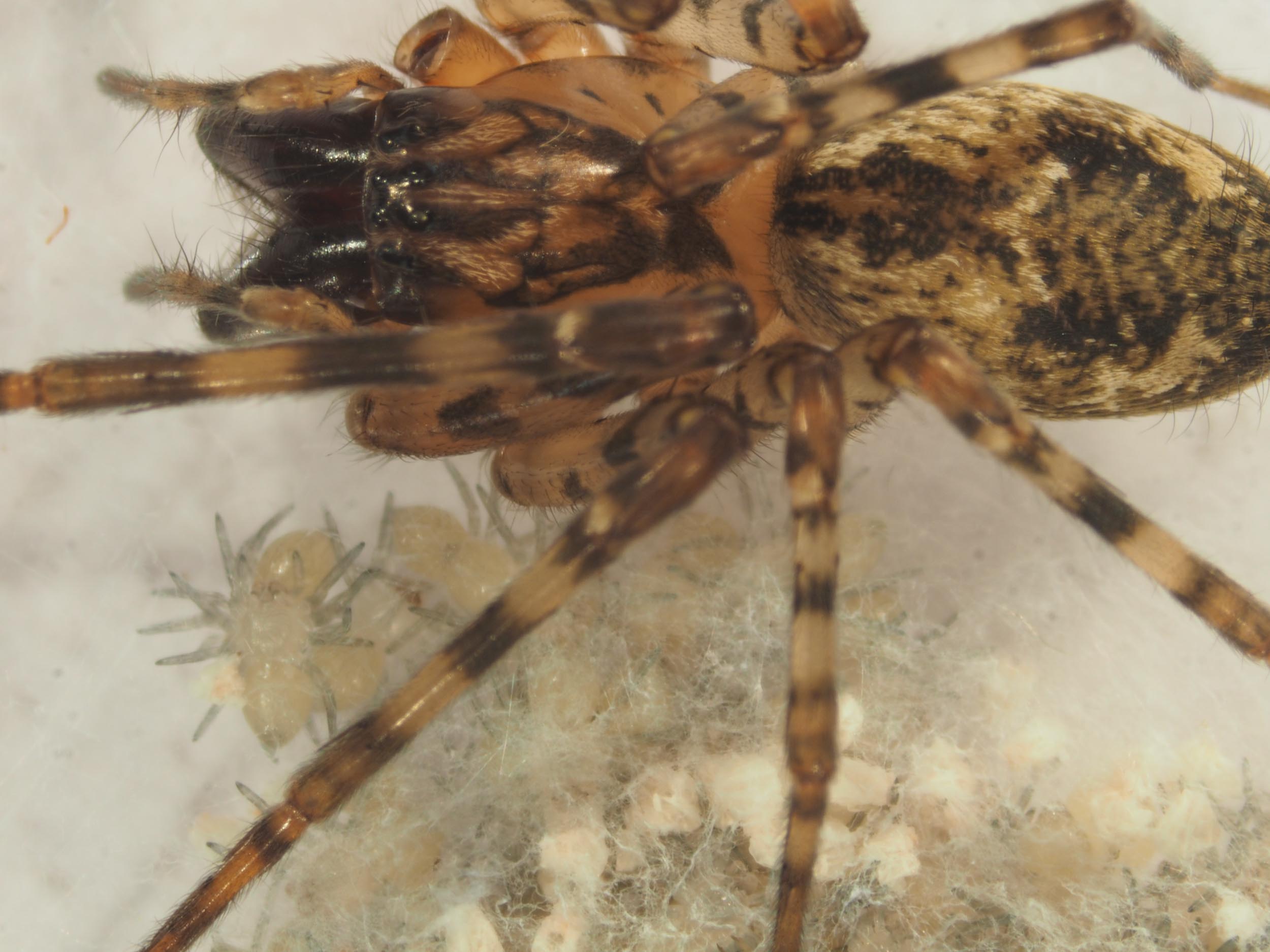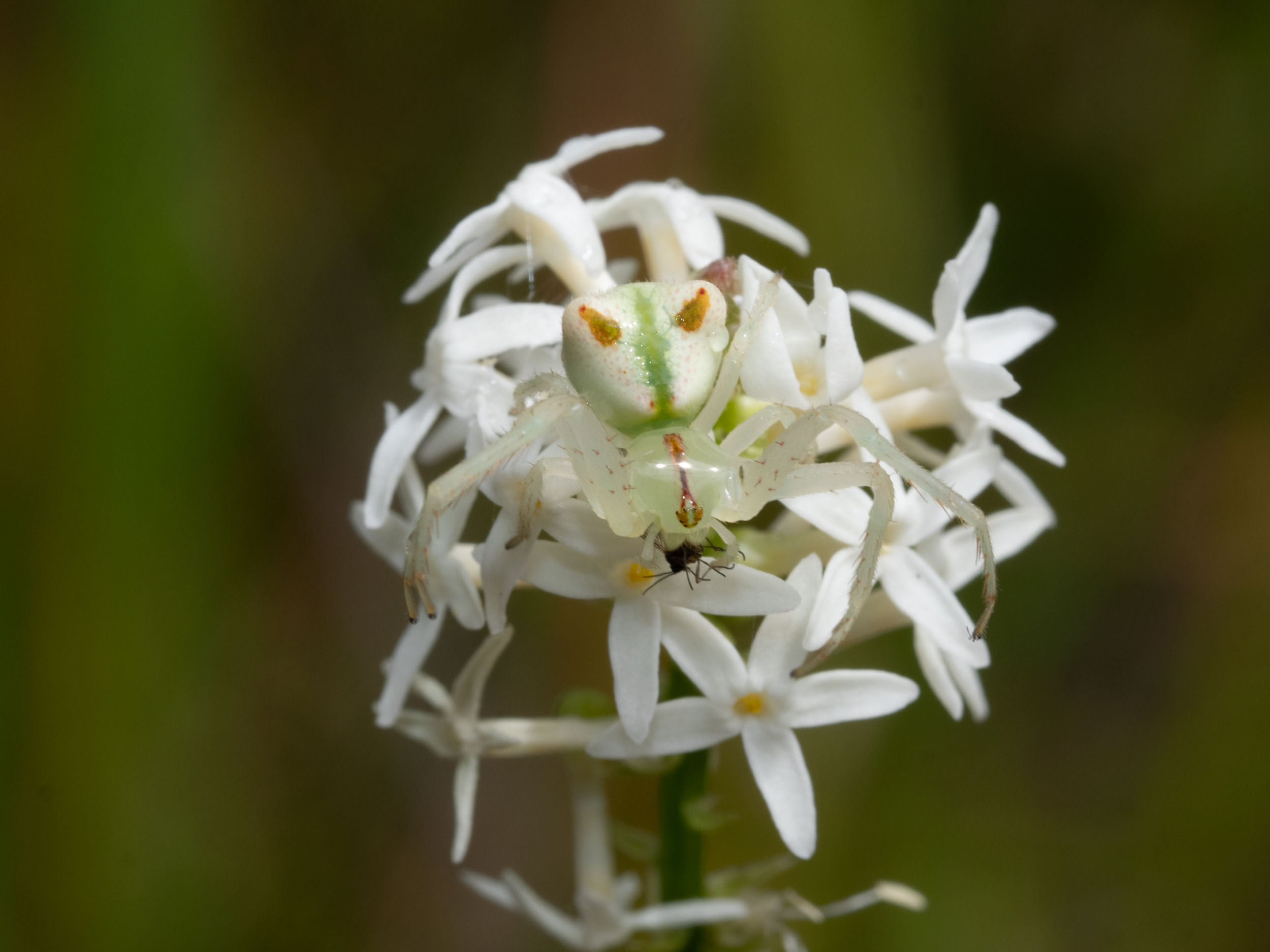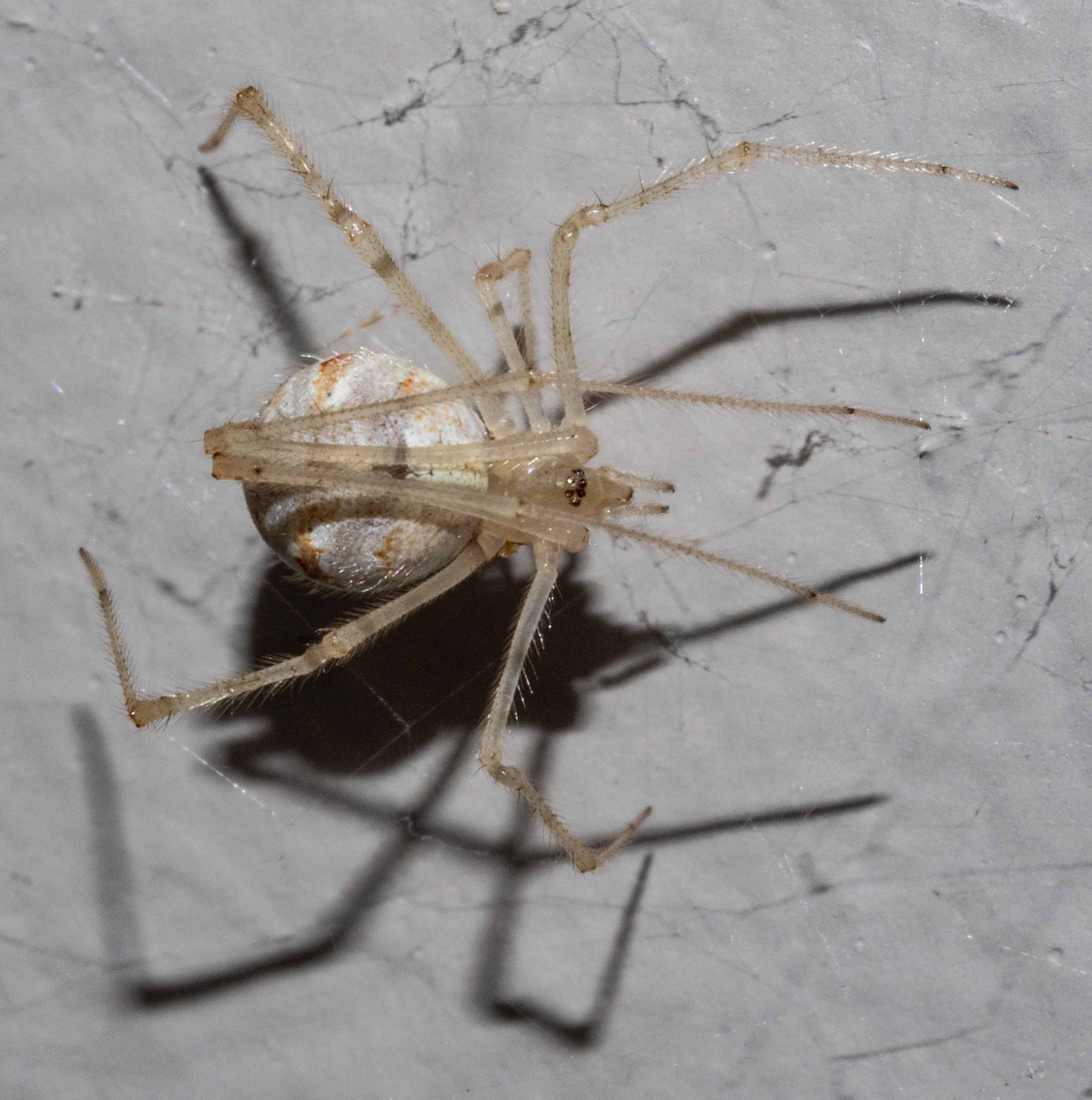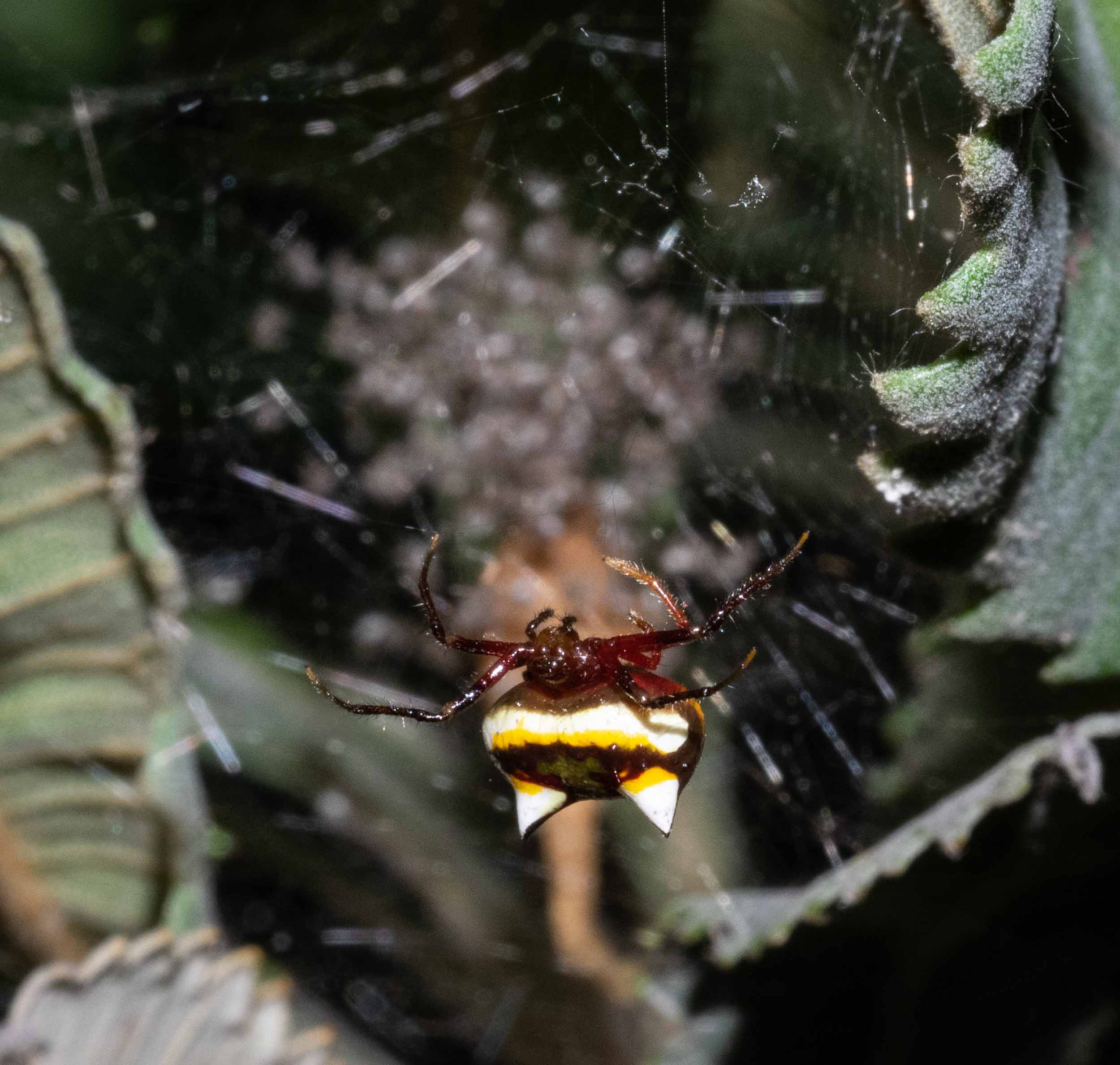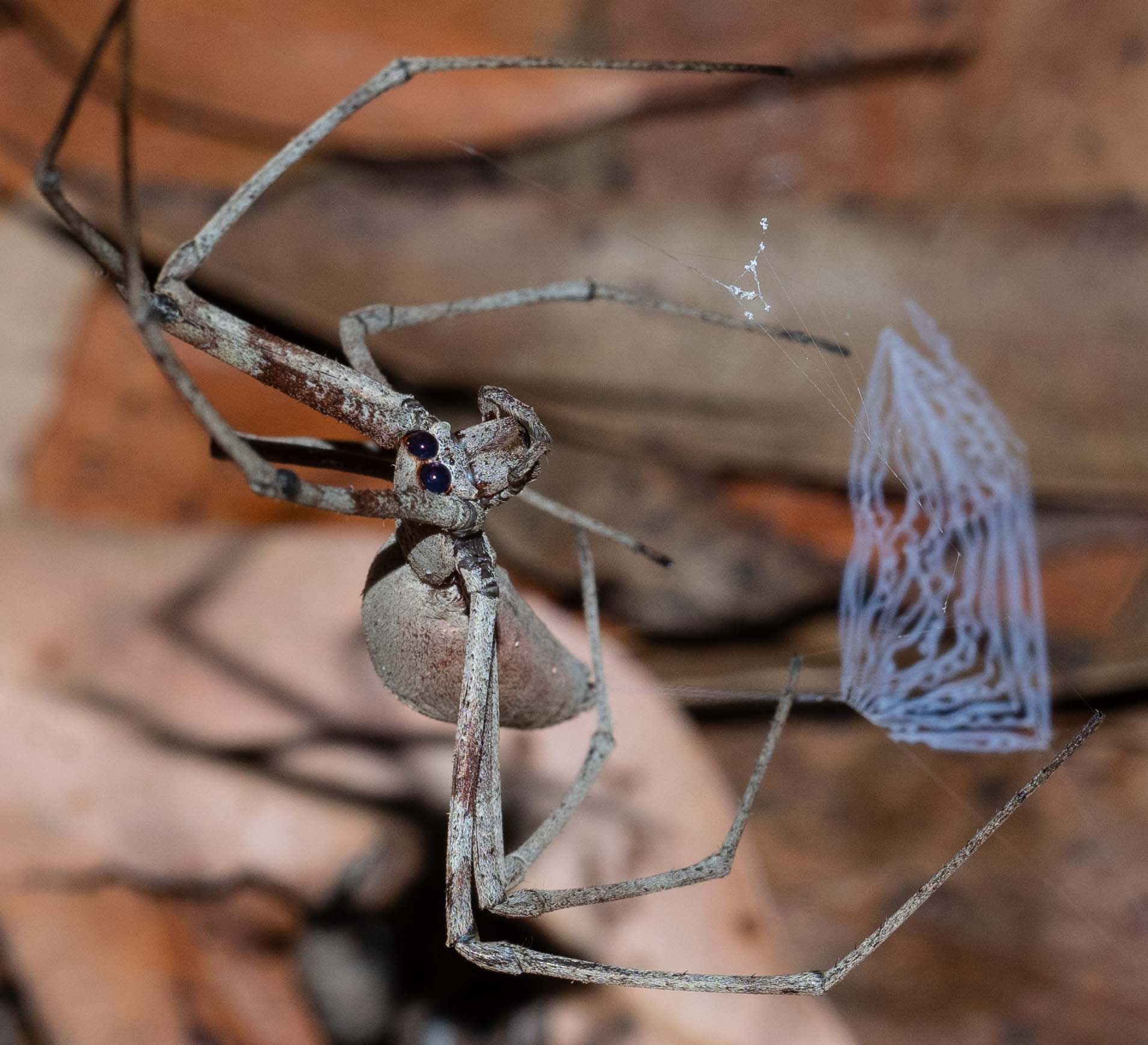Getting to know Mygals

Spiders occupy a central place in the forest ecosystem, as both predators and prey. Over the years we've come to know our local spiders quite well, having identified 100 different species. However, until recently we hadn't sighted a single representative of the ancient spider group Mygalomorphae on the block.
What are Mygals?
About 240 million years ago, a key branching event occurred in spider evolution. The order Aranaea split in two. One branch gave rise to the Araneomorphae, the other to the Mygalomorphae. An extensive radiation occurred in the Araneomorphae – as a result, we have over 30 different families of these spiders in Australian today. They display an incredible diversity of body shape, behaviour and lifestyle.
Radiation of the Mygalomorphae was much more limited, resulting in around 9 different families of spiders. But these include a couple of iconic Australian groups - the Funnelwebs and the Trapdoor Spiders.
Recent sightings of mygalomorph spiders
We have been on the lookout for mygalomorphs since moving to our home in the forest. But the closest we had come until very recently was the discovery of the small, but impressive looking individual below. Kerri found it crossing a nearby road during the day in late Spring. It looked like a mygalomorph, but which species? We thought we knew at the time, but our identification turned out to be way off the mark. I'll return to the identity of this critter later...
On reflection, the dearth of sightings of mygalomorphs is not surprising. They are generally nocturnal creatures and spend most of their time hidden in the ground in burrows.
Then on a rainy night about a week ago we hit the jackpot! We found several mygalomorph-looking spiders wandering around outside the house. Indeed, some were on the house walls!
I have subsequently read that male mygalomorph spiders wander around on rainy nights in late Autumn in search of mates. We were fortunate to have been wandering around in search of moths on the same night as the mygals.
But who are these guys? I realised straight away that this was going to take some sorting out. They all looked pretty much the same to my untrained eyes. After trawling through various guide books, websites and research papers for several days I was able to arrive at a tentative identification of most of them. Along the way, I've become much better acquainted with Mygals!
Let me take you through the steps on this journey. Beyond the specifics of mygalomorph identification, it may serve to illustrate what's involved in working out who's who amongst a group of look-a-like invertebrates.
The identification process involves a series of decision points, each step corresponding to a different level of the taxonomic hierarchy. It is essentially a process of progressively limiting the options until you arrive at just one final choice - the species!
Here is the series of questions I asked myself for each spider under study:
Infraorder (Mygalomorph or Araneomorph)?
Family?
Genus?
Species?
I'll illustrate these steps for three of the four species of mygalomorphs we've found to date.
At the outset, note that it is important to know the sex of your spider. Male spiders often differ substantially from females.
If you can get it, choose a male. In most cases only male spiders have a distinctive enough morphology to enable them to be identified to the genus, let alone species level. Fortunately, all of the mygalomorphs I had collected were males.
Case Study #1 - Mouse Spider, Missulena dipsaca (Family Actinopodidae)
This is the spider featured at the beginning of this post, which Kerri found on the road in late Spring.
First Step - Mygalomorph or Araneomorph?
The first step, working out whether the spider is a mygalomorph or araneomorph, involves the same test for all spiders and is easy. Just flip your spider over and look at the bottom side of its abdomen (called its venter). Alternatively (and more judiciously) place it in a covered, glass-bottomed container and view from below.
A look at the venter of this spider reveals two pairs of book lungs. These are the dark purple oblong structures (arrowed), which are the spider's gas exchange organs.
All mygalomorphs have two pairs of book lungs, whereas all araneomorphs have only one pair.
So this is definitely a mygalomorph.
Second step - which mygalomorph family?
I was able to work this out quite quickly by looking at the eye pattern.
The most lateral eyes of this individual (arrowed in the photos) lie quite close to the edge of the carapace. This places it in the family Actinopodidae - Mouse Spiders. All other mygalomorphs have a more compact eye arrangement.
Confirmation that it is indeed a Mouse Spider is provided by the fact that the sides of the caput, the elevated portion of the carapace, are near vertical.
Third step - which genus of Actinopodidae?
This is easy! There is only one Australian genus in this family, Missulena.
Fourth step - which species of Missulena?
Not so easy. The Atlas of Living Australia lists 14 Missulena species. The job became more manageable when I found a list showing the locations on a State by State basis of all Missulena species. This gave me 3 candidate species, one of which, Missulena occatoria, I could exclude straight away, as the male has a red caput and chelicerae (jaws). This left two alternatives - Missulena bradleyi and Missulena dipsaca.
Images of Missulena bradleyi males in handbooks and on the internet looked different to my spider. The carapace and chelicerae of that species is not as bumpy, the abdomen has fewer hairs and bears a distinctive blue patch. But to verify my spider was indeed Missulena dipsaca I dug out the paper in which this species was first described (ref. 1).
My spider matches the author's description closely.
In particular it possesses a key distinguishing feature - a cluster of narrow spines adjacent to the base of the fangs (arrowed in adjacent image).
So I have tentatively identified this spider as Missulena dipsaca.
Mouse Spiders are unusual amongst mygalomorphs in being active during the day. The males can be found wandering around in search of females, just as Kerri discovered. The females tend to hang out in their well-camouflaged burrows.
A recent review of Australian spider venoms (ref. 2) states that several of the toxins in the venom of Missulena species have a very similar structure and biological activity to those in Australian Funnelweb Spiders. However, there is only one report of serious medical effects resulting from a Mouse Spider bite. It is speculated that their bites are generally "dry". But still, it is wise to exercise caution when handling them!
The individual we collected was reasonably feisty, although, lacking a collecting dish, Kerri did manage to carry it back home balanced on the screen of her mobile phone!
Case Study #2 - Spiny Trapdoor Spider, Arbanitis melancholicus (Family Idiopidae)
Let's take a look at our next mygalomorph. This was one of the creatures we found wandering around the house when it was raining spiders. The yellow objects near the middle of the carapace are mites - common parasites on spiders. You can tell this one's a male because the tips of the pedipalps, the first pair of appendages are enlarged.
The pedipalps house the organ used by the male to transfer sperm to the female's genital opening. This organ looks and functions like the plastic bulbs used to dispense drops of solution for eye washing. The swollen base, the bulb, houses the sperm, which are ejected through the extended pointed part, called the embolus, shown in the adjacent image of a pedipalp from a different spider species.
First Step - Mygalomorph or Araneomorph?
This spider was very accomodating when it came to getting a view of its venter. It froze, playing dead when touched and could be turned over on its back. This very passive response to threat turns out to be a feature of this family. Be aware that other mygalomorphs can show a very different response - namely, naked aggression! See Case Study #3 spider below, for example.
A view of the venter shows two pairs of book lungs - coloured yellow - confirming we are dealing with a mygalomorph.
Note, too, the two pairs of spinnerets at the end of the abdomen. The longer pair barely extends beyond the tip of the abdomen.
The venter is pale coloured with just a few scattered dark dots of pigment. These two features will assist identification.
Second step - which mygalomorph family?
The eye arrangement proved useful in identifying the previous spider. What does it look like for this one?
I've numbered the eyes in this image. Eyes 1-4 are in the rear row, 5-8 in the front row.
Clearly, the eyes have a more compact eye arrangement than that seen in Mouse Spiders. So we can exclude the family Actinopopidae.
The eyes of Brush-footed Trapdoor Spiders are mounted on a raised platform or tubercle, which is not the case for this spider, so we can rule out family Barychelidae.
By itself the observed eye arrangement does not rule out other mygalomorph families. However other features come to the rescue.
Our spider lacks the distinctive saddle-shaped dent in the middle of the third leg seen in Saddle-legged Trapdoor Spiders (Family Ctenizidae).
It lacks the very long spinnerets found in Curtain-web Spiders (Family Dipluridae).
It is larger than Tree Trapdoor Spiders (Family Migidae) and lacks the oblong carapace shape of that spider group.
The spinnerets of Wishbone Spiders (Nemesiidae) project further from the abdomen than those in our spider.
It is much smaller than Australian Tarantulas (Family Theraphosidae) and lacks the long spinnerets and thick, very hairy legs of those spiders.
Finally, the caput is covered in fine, golden hairs rather than being glossy, as is the case in Australian Funnelweb Spiders (Family Atracidae). Its spinnerets are also shorter than those of Funnelwebs.
Which mygalomorph family is left? - the Spiny Trapdoor Spiders (Family Idiopidae).
Other features are consistent with a Spiny Trapdoor identity for this spider:
the front row of eyes (numbers 5-8) is curved downwards
the eye field is wider than long
the spinnerets are short, just projecting to the end of the abdomen
the presence of a double spur on the tibia of the front pair of legs (see arrows in images below). These may be used to manoeuvre the female into position during courtship and mating.
Third Step - which genus of Idiopidae?
Unlike the Mouse Spiders, there is more than one genus in the Idiopidae. A very recent revision of this family (ref. 3) lists 10 genera. Obligingly, the authors also provide a key to these genera. My Spiny Trapdoor Spider keys out to the genus Arbanitis.
The identifying features include:
eye group rectangular, anterior eye row curved
many fine golden hairs on carapace
two processes (RTA and dRTA) on the male pedipalps - see image below
tip of the embolus is not bifurcate
Fourth step - which species of Arbanitis?
This gets really tricky as the latest revision of this genus lists 61 species! However, using the keys in two earlier papers (ref. 4,5), I was able to provisionally identify my spider as Arbanitis melancholicus.
The key identifying features of this species are shown in the images of the pedipalp above and the bulb and embolus below:
presence of a small process (apophysis) located halfway along the embolus
embolus is straight rather than twisted and has a bend
the distal retrolateral tibial apophysis (dRTA) is hooked
the dorsal surface of the cymbium is covered in spines
the venter has only a few scattered dark spots (see ventral view of spider above)
Arbanitis melancholicus is reported to be widespread in NSW, but is said to be rarely found south of Sydney (ref. 4). The discovery of this species in our forest, just 30km north of the Victorian border, considerably extends its known range. As a group, spiders have been relatively neglected in fauna surveys and hence reported distributions of individual species should be interpreted with caution.
As mentioned earlier, Arbanitis is just one of 10 genera of Australian Spiny Trapdoor spiders. It is the dominant genus on the east coast and south-eastern Australia. A related species to Arbanitis melancholicus, Arbanitis villosus - the Sydney brown trapdoor spider - is probably one of Australia's best known spiders, being a common inhabitant of backyards in Sydney.
Confusingly, only a couple of the 61 species of Arbanitis live up to their name and make a door to their burrow. The remainder build open burrows, camouflaging the entrance with leaves or silky threads.
Door building is the rule amongst several of the other Spiny Trapdoor genera, including Blakistonia and Idiosoma, which are found in drier areas of the country, away from the east coast. There is good evidence that building a door to the burrow was the ancestral condition in the family Idiopidae and that this feature was lost in the genus Arbanitis. Interestingly, this means that this behaviour must have secondarily evolved in species such as Arbanitis gracilis, which does build a door.
Bites from Spiny Trapdoor Spiders are reported to be painful, but apparently do not result in serious medical conditions.
Finally, here's an interesting factoid about Spiny Trapdoor Spiders. The females can be very long-lived. The world's oldest spider, a trapdoor belonging to the genus Gaius, recently passed away at the age of 43! This spider had been the subject of a long term study by one of Australia's most eminent arachnologists Barbara York-Main. This article, which originally appeared in the Washington Post, gives a very nice account of this story.
Case study #3 - Australian Funnelweb Spider, Hadronyche nimoola (Family Atracidae)
My third mygalomorph spider turned out to be a pretty special creature, belonging as it does to one of Australia's most infamous spider families. But more about that later...
First Step - Mygalomorph or Araneomorph?
First off - a view of the venter. Yes, this is definitely a mygalomorph - two lovely pairs of book lungs.
Second step - which mygalomorph family?
The straight, broad front to the carapace and its glossy black, smooth appearance gave me a hint that this spider belongs to the family Atracidae - the Australian Funnelweb Spiders. (Note that the family Atracidae was until recently considered to be a subfamily Atracinae in the family Hexathelidae. Hedin et al elevated these spiders to full family status in 2018 - ref. 6).
A number of other features are consistent with that identity:
the compact, rectangular arrangement of the eyes
the massive chelicerae
the relatively long legs
the posterior pair of spinnerets project well beyond the end of the abdomen
Third Step - which genus of Atracidae?
The 3 genera of Atracidae - Atrax, Illawarra and Hadronyche - all have the same general body shape and colouration of my Funnelweb Spider.
Fortunately, there is a simple body feature that can be used to decide between those alternative genera. Viewed from the side, it is apparent that the caput of my spider rises up steeply from the carapace. This indicates that it belongs to the genus Hadronyche - the caput of Atrax and Illawarra spiders rises up more gently from the carapace.
Other features consistent with genus Hadronyche are:
absence of a protruding bump (apophysis) on the tibia of the second pair of legs
the thick, massive base to the chelicerae
presence of a long row of central cheliceral teeth (marked by asterisks in the image below)
Fourth step - which species of Hadronyche?
The revision by Gray, 2010 (ref. 7) of the Atracidae (at the time considered to be a subfamily in the Hexathelidae) lists 31 species of Hadronyche (ref. 7). Using the key in that paper, I have arrived at Hadronyche nimoola as the identity of my spider. This is based on the following features:
it is a relatively small spider; the carapace length is 6.5mm, within the range reported for this species
the caput is high and wide and rises steeply from the carapace; it is almost bulbous
the tibia of the second pair of legs shows no sign of a protuberance (apophysis)
tibia I and metatarsus I are not thickened
tarsi I and II have relatively few teeth on the claws - just 7 (see LH image below)
the embolus is rather short and strongly tapered distally (see RH image below)
This identity fits with the reported distribution of the species on south coastal regions of NSW, including sightings from locations within 60km of our block.
The only other Atracidae species that has been reported in our area is Atrax sutherlandi. I have examined a specimen of Atrax sutherlandi found by a neighbour and it is clearly different to my spider, having a low caput.
Hadronyche nimoola belongs to the same family as Atrax robustus, the Sydney Funnelweb Spider. The question arises as to whether it is as venomous as that species, which was responsible for 13 deaths before an antivenom was developed in 1981.
The recent review of Australian spider venoms (ref. 2) mentioned above states that the toxin that is responsible for the envenomation effects of Atrax robustus - a peptide called delta-HXTX-1 - is also present in a range of Hadronyche species and has similar biological activity. Furthermore, the Atrax antivenom has been shown to reverse the envenomation syndrome of Hadronyche spiders.
Given these facts, any of the Atracidae spiders should be handled with care (or not handled at all)! The Hadronyche nimoola individuals we collected were all quite feisty, raising their fangs when disturbed.
Funnelweb Spiders have poor vision. They rely on vibrations to detect passing prey, as they sit near their burrows. They are also incapable of jumping, so I felt reasonably safe taking the above photo!
We found three Hadronyche nimoola on that one rainy night a week ago but haven't sighted any since. Perhaps the female hunting season is over?
My seven Mygals Identified
A. Missulena dipsaca B. Hadronyche nimoola E. Arbanitis sp. F. Arbanitis melancholicus G. Arbanitis melancholicus
C and D. remain a mystery … for now
Update: Three years after writing this blog, we had a definite identity for spiders C and D. It’s no wonder we had trouble identifying these individuals at the time. They both turned out to be a new species of mygalomorphs and specifically a new funnel-web spider, which we described, published and named in November 2021 - Hadronyche nadgee!
You can read the full story about how we came to recognise this was a new species and the process of describing and publishing it in Kerri’s blog “Introducing the Nadgee Funnel-web”.
References:
Fauldner, R.J. "Two new species of the Australian spider genus Missulena Walckenaer (Araneae: Actinopodidae)." Records of the Western Australian Museum Supplement No. 52: 73-78 (1995).
Wilson, D.T.R. "The venom of Australian spiders" in "Spider Venoms" pp.1-20. Springer Science+Business Media. Dordrecht. (2015). (this article can be accessed from the JCU website here).
Rix, M.G. et al. "The Australian spiny trapdoor spiders of the family Idiopidae (Mygalomorphae: Arbanitinae): a relimitation and revision at the generic level." Invertebrate Systematics 31: 566-634 (2017).
Wishart, G. "Trapdoor spiders of the genus Misgolas (Mygalomorphae: Idiopidae) in the Sydney Region, Australia, with notes on synonymies attributed to M. rapax." Records of the Australian Museum 58: 1-18 (2006).
Wishart, G. and Rowell, D.M. "Trapdoor spiders of the genus Misgolas (Mygalomorphae: Idiopidae) from eastern New South Wales, with notes on genetic variation." Records of the Australian Museum 60: 45-86 (2008).
Hedin, M. et al. Phylogenetic reclassification of the world’s most venomous spiders (Mygalomorphae, Atracinae), with implications for venom evolution. Scientific Reports 8: 1-17 [4] (2018).
Gray, M.R. "A revision of the Australian Funnel-web Spiders (Hexathelidae: Atracinae)." Records of the Australian Museum 62: 285-392 (2010).
























